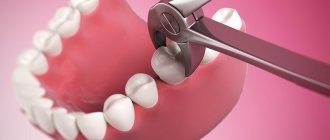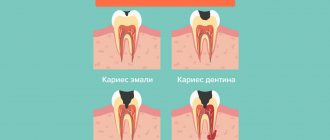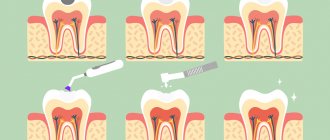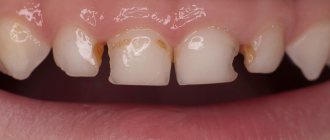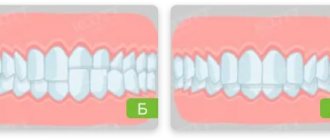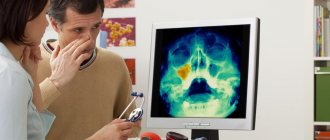Pain during treatment in the dental chair was considered normal for many years. Because of this, patients developed fear. As a result, many people put off visiting the doctor, causing irreparable damage to their teeth. Both patients and doctors are interested in painless treatment.
Anesthesia can completely eliminate unpleasant sensations, but in a clinic setting this method cannot always be implemented. The safest and most common solution if treatment is required to remove teeth without pain is to use local anesthesia. Medicines for it are constantly being improved, allowing the doctor to choose the optimal medicine in each individual case.
Phobia or simply fear of dentists
A common fear of a drill can always be distinguished from such a serious problem as dental phobia. If a person goes to talk to a doctor, then most likely he is simply afraid. In this case, the specialist’s task is to find an approach to the patient and choose the right words. When a person realizes that there is nothing to be afraid of, he relaxes and may even fall asleep during the appointment. This happens only because he found contact with the doctor and trusted him. A patient suffering from dental phobia is non-communicative, he can faint only at the sight of a syringe, during the treatment he begins to interfere with the doctor with his hands or feet, he develops shortness of breath, his blood pressure rises sharply... In such situations, it becomes obvious that the person is really not able to control your fear, and this is a serious psychological problem.
What to do if only cold water helps with pain
At a certain stage of the disease (in particular, with gangrenous pulpitis), rinsing with cold water can help. Please note, under no circumstances is it icy. Rather, we are talking about water at room temperature, which is perceived by our body as cold.
It will not be possible to completely remove toothache, but it is quite possible to alleviate your condition a little. When cooled, tissue swelling decreases slightly and the feeling of fullness goes away. When heated, the pain occurs again, some feel it with a vengeance. Regular rinsing every 5-10 minutes will help you get to the doctor, but will not remove the cause.
It is not recommended to use ice water for such purposes, since with a large temperature difference, cracking of the enamel is possible. This effect is especially unfavorable in cases of hypersensitivity. You can try to apply any cold object to the cheek on the sore side, but, again, not for long, to avoid possible inflammation of the trigeminal nerve (and this is another and also not a very funny story).
Important! Do not heat your cheek on the sore side and do not rinse your mouth with hot water. It's not guaranteed to help, and it's sure to make things worse.
Techniques that help to carry out dental treatment without pain
For patients who suffer from dental phobia, treatment under sedation is essentially a light medicated sleep. Under the influence of a special drug, a person gradually calms down and falls asleep, and wakes up with already cured teeth. This is also a great option for those who are simply afraid of dental treatment. But, in addition to the fear of the dentist’s intervention, there are a number of very important indications for sedation. These are allergies to local anesthetics, which are now very common, cardiovascular diseases, hypertension, a recent heart attack, epilepsy... Sedation allows you to mitigate the risks that may arise during the treatment process associated with these serious diseases. The use of general anesthesia or anesthesia in dentistry is allowed only in cases where it is really necessary.
When not to use local anesthesia
Anesthetics injected into the gums should not be used if the patient is allergic to them. They are also prescribed with extreme caution to persons who have diseases of the cardiovascular system, thyroid gland, or diabetes. In all these cases, complex dental interventions are carried out strictly in a hospital setting.
Before administering an anesthetic, the patient must tell the doctor what acute or chronic diseases he has. This will allow the doctor to make the right decision at the stage of choosing a method of pain prevention.
Difference between sedation and anesthesia
Sedation is simply a sleeping pill that puts the patient into a shallow sleep. At the same time, he breathes on his own, he retains all vital reflexes, he can respond to the doctor’s requests, and after the procedure he can calmly go home. Anesthesia is more global. The patient is put into deep sleep, undergoes mandatory intubation, and during the treatment, his breathing and cardiovascular activity are supported and controlled by devices. After recovering from anesthesia, he must be under the supervision of a doctor for at least 30 minutes, and to return home he must be accompanied by someone close to him. Therefore, use general anesthesia only because the patient is afraid. In addition, there are sad statistics according to which, after dental treatment under anesthesia, fear not only does not go away, but intensifies even more.
Icon: caries treatment without preparation
In the early stages of caries, Icon dental treatment is successfully used when drilling is not required at all. Dental surfaces are treated with a special chemical composition, which, permeating the tissues, disinfects and seals them. Essentially, a special filling is placed on the tooth, but you don’t have to drill into it for this filling. Unfortunately, treatment of caries without Icon preparation can only be used at the beginning of the development of the disease, when there is not yet a deep cavity in the diseased tooth. Therefore, for those who want to be treated quickly and painlessly, without an unpleasant preparation procedure, it is better to consult a doctor at the first signs of caries.
Veronika Aleksandrovna Ivantsova, dentist at the 32 Dent clinic: “The Icon dental treatment today is the most famous and popular technique that does not require drilling of dental tissue. But besides this, there are other technologies without preparation: ozone therapy, when diseased cells are removed by ozone cleaning, a non-contact abrasive technique, which is very similar in its mechanism of action to regular teeth brushing. In a modern, well-equipped clinic, the patient can always be offered a choice of several options for painless and completely comfortable treatment.”
Types of dental treatment and sedation
Almost all types of dental treatment can be performed under sedation, but the question here is whether it is appropriate. It is reasonable to use sedation during global long-term treatment, lasting more than 3-5 hours, when it is simply uncomfortable for the patient to lie with his mouth open. It is also used in cases of implantation or during open and closed sinus lifts, where it is important to reduce excessive patient activity for safety reasons. In addition, sedation is used in the treatment of children under 3 years of age diagnosed with bottle caries, when it is necessary to treat 6 - 8 teeth. It is important to note that sedation is not anesthesia in dentistry and is used in conjunction with local anesthesia.
Pain-free dentistry: protect and prevent
It is much easier to prevent any disease, including dental disease, than to then deal with the consequences: competent prevention will help protect yourself from both caries and periodontitis, which means you will not have to deal with the need for treatment. But good home hygiene alone is not enough for prevention. The best way to protect yourself from dental diseases is to have your teeth professionally cleaned. A simple, absolutely painless and comfortable procedure will not take much time, but will remove all plaque and tartar, which usually cause caries.
Ultrasonic tartar cleaning, laser tartar cleaning and Air-Flow - all these modern techniques do not require anesthesia, because they involve a very soft, gentle effect on the dental surfaces and do not cause any discomfort. Carrying out ultrasonic or laser removal of tartar once every six months will reliably protect your teeth and gums from diseases, which means there will be no reason to go to the dentist for treatment.
Dental hygienist at the 32 Dent clinic, Varivoda Violetta Vladimirovna, says: “Modern teeth cleaning is not at all similar to removing tartar with metal dental instruments, which was practiced 10-20 years ago. Today, hard and soft plaque is removed very carefully, accurately and completely painlessly. For example, laser cleaning of teeth from stone occurs very quickly and is almost unnoticed by the patient. Even our most “fearful” patients feel quite comfortable when undergoing such a procedure.”
How many teeth can be treated in one visit?
There are no restrictions on volume, the main thing is that it takes a maximum of 6 hours. But if you plan to treat several teeth in a row, then dentists usually do not undertake to do everything in one visit: after treatment, post-filling pain may occur, in which case the doctor will not be able to determine which tooth is bothering the patient. But there is another side to the issue. In order to avoid putting a person into a state of sedation once again, sometimes it makes sense to take a risk and do everything to the maximum.
Is it possible to have a painless injection?
Most patients, even when performing a simple filling, ask for an anesthetic injection to stop experiencing fear of sudden pain. But such an injection in itself is quite unpleasant. To reduce the pain from an injection, doctors use:
- Special carpule syringes with thin needles.
- Before the injection, the mucous part is dried with a dental hair dryer so that penetration is painless.
- The injection site is treated with anesthetic ointment or gel.
- The medicine is administered very slowly, so after the first dose is administered, the patient will not feel the second.
The problem of medical errors in dental treatment without pain
Many experts argue that when treating teeth under sedation or anesthesia, the likelihood of medical error is greater than when using local anesthesia. It all depends on the professionalism of the doctor and anesthesiologist. The latter must quickly put the patient into a state of sedation or anesthesia and quickly remove it from it, and the dentist must have time to do everything necessary during this time. If the team is well-coordinated, and before the procedure the patient is properly interviewed, fully examined, and planned what they will do, then errors are minimized. We already have legal proceedings, as is customary in America and Europe. A doctor is unlikely to risk his job, position, diploma just to do something wrong while the patient is sleeping.
What to do if your tooth hurts at night
Physiologically, the most difficult time for a person is from midnight to 5 am. By evening, the level of corticosteroids in the blood decreases, which reduce pain. That is, by night a person is left alone with himself, in this case with his pain.
Unbearable night pain is characteristic of pulpitis. In a horizontal position, blood rushes to the head, increasing pressure on the nerve roots. The “half-sitting” position will help ease the situation a little. Raise the pillow higher so that your head is higher than your torso.
It is unlikely that shallow caries will make itself felt at night, but if you have periodontitis, periodontitis and gingivitis, such manifestations are quite real. The pain can be pulsating, localized, and accompanied by an additional burning sensation. In the worst cases, it feels like half your head hurts.
Mild pain may occur the first night after a nerve or tooth is removed. Take a tablet, rinse your mouth with a soda solution - these simple steps should help you quickly. You can also use folk remedies - clove oil, apply garlic.
As an option for severe pain, apply something cold to your cheek. Ice or even a piece of frozen meat will do. The only thing is to wrap it in a cloth or towel. Take any of the analgesics - Nurofen, Analgin, Ibuprofen, Nise, Tempalgin, Pentalgin, Ketorol.
Need to know! No-shpa tablets do not help against toothache; there is no point in taking them.
In what cases should you consult a doctor immediately?
In some situations, not taking action can have a detrimental effect on your health. Turning to folk remedies or tablets from your home medicine cabinet will result in a loss of time and a deterioration in your condition.
If you notice at night:
- temperature increase;
- severe swelling on one side of the face;
- difficulty breathing and swallowing;
- cardiopalmus;
- loss of sensation in the affected part of the head
We call an ambulance or look for a clinic that provides 24-hour dental care.
Important! Breathing problems are especially dangerous, which may indicate incipient swelling of the larynx.
Other causes of night pain
Quite often a person perceives pain as toothache, although its cause lies in diseases of a fundamentally different nature. This pain also appears or intensifies at night or late in the evening.
We are talking about diseases such as:
- Inflammation of the trigeminal nerve.
The branches of the nerve are located very close to the roots of the teeth; when inflammation occurs, pain similar to toothache occurs. The nature of the pain is nagging and at times quite strong, localized or spreading throughout the jaw. - Sinusitis, sinusitis, otitis.
Accumulated in the sinuses and tissues, purulent accumulations put pressure on the roots of the teeth, causing discomfort. Quite often, a similar situation occurs in children who find it difficult to determine the source of pain. - Stress.
Night toothache occurs as a reaction of the body to constant nervous tension.
Only a doctor can determine the cause. To make a correct diagnosis, you will still have to visit a dentist to rule out diseases of the teeth and oral cavity. Therefore, we recommend not to delay visiting the doctor in order to avoid possible complications as much as possible.
How often can teeth be treated using sedation therapy?
Until now, many patients and even doctors are afraid of everything that is in one way or another connected with anesthesia, because previously heavy drugs with a lot of side effects were used for this. But since then, everything has changed dramatically: a huge amount of research has been carried out, many new medicines have been released. Today, anesthesiologists use the latest generation of drugs that have virtually no side effects; their contraindications are limited to the third and first trimester of pregnancy, lactation, as well as banal intolerance, which can even occur with aspirin.
How to relieve toothache at home
There are situations when there are no painkillers on hand and it is not possible to buy them at the nearest pharmacy. In this situation, you can try to reduce the discomfort with folk remedies. But you still shouldn’t count on their effectiveness and duration of action. They do not always help and not everyone.
Propolis
Has a bactericidal and anti-inflammatory effect. Can be used in pure form or in the form of tinctures.
Chamomile
A well-known folk remedy used to reduce pain and relieve inflammation. It has virtually no contraindications.
Ginger
It has anti-inflammatory and analgesic properties. You can apply it raw to the sore spot or make a decoction.
Carnation
Has an analgesic effect. Chew one stick of cloves or lubricate the sore tooth with clove oil.
Hypertonic solution
Dissolve 2 teaspoons of table salt and 1 teaspoon of baking soda in half a liter of warm boiled water. Rinse your mouth with this solution 3-4 times a day.
We do not advise children and women to use folk remedies for toothache during pregnancy in order to avoid the development of an allergic reaction.
If in the evening, in addition to acute, aching pain, you have swelling and a rise in temperature, and there is no 24-hour dentist on duty in the city, contact an ambulance for emergency help. The paramedic will give you an injection of pain medication and you will be able to wait until you see the doctor.
Sedatives
Intravenous sedation is more convenient and safe. Throughout the procedure, the patient's pulse and blood pressure are monitored by an anesthesiologist-resuscitator. It also controls the depth of sedation: at the right time it prolongs its effect. The drug has sedative, muscle relaxant, anticonvulsant pharmacological properties. Its advantage is that it has an antidote that stops or weakens the effect of the drug on the body. After its administration, the patient immediately wakes up and feels great. Perhaps a little sleepy for an hour, but nothing more.
Where can you cure caries painlessly?
Regardless of what teeth need to be treated, you need to pay special attention to finding an experienced specialist. At the same time, it is very important that he conducts the appointment in a well-equipped dental center.
These requirements are fully met by the Line of Smile clinic. We employ doctors with extensive experience. They have access to the most effective and safe painkillers, so when you contact us, you don’t need to think about whether it’s possible to treat your teeth without pain. We guarantee each of our clients comfortable service conditions.
Do patients who are afraid of dental treatment always need sedation?
Sedation is not a panacea in the fight against fear, it is simply an emergency measure. It very effectively helps to level it out or get rid of it altogether. The fact is that the big advantage of sedation is the absence of memories. The man remembers sitting in a chair, but nothing more. This means that even if there was discomfort during treatment, no unpleasant emotions will remain. It turns out that after having his teeth treated several times under sedation, a person understands that nothing bad is happening to him, and before his next visit to the dentist he no longer experiences such strong fear as before, which means he can try treatment without sedation. At first, of course, the patient may remain tense, but then a feeling of relaxation sets in.
Why can your teeth hurt?
Toothache in adults and children can occur for various reasons. Here are the most common ones.
Dental diseases
Pain is one of the symptoms of caries, pulpitis, periodontitis, exposure of the neck of the tooth, enamel erosion, abscess, retention (delayed eruption) of teeth and many other diseases of the oral cavity.
Sinusitis
If you have a stuffy nose, you feel weak in the body and the entire upper jaw hurts, the reason for this may be accumulated pus in the paranasal sinuses.
Food leftovers
Sometimes food gets stuck in the spaces between teeth, which are difficult to clean with a regular toothbrush. When food remains get stuck under the gums, they can cause inflammation of the gums and severe toothache.
Bruxism
If your teeth hurt in the morning, your head hurts, and you feel like you haven't slept at all, you may be suffering from involuntary teeth grinding in your sleep.
Lost filling
The service life of the filling is 5–7 years. If it is not replaced in time, it may fall out unexpectedly one day. In this case, pain usually occurs while eating.
How to treat caries: the main stages of the treatment process to be completed
Treatment of caries always begins with diagnosis, which establishes the stage of development of the disease. Diagnostic measures for caries may include a visual examination, the use of special caries indicator drugs, a laser, and radiography (a targeted picture is taken).
Based on the data obtained during diagnosis, the optimal caries treatment method for a specific clinical case is selected. Most often, a classic treatment regimen is used, which involves drilling the tooth with the removal of destroyed tissue, treating it with antiseptics and drugs that destroy the infection, and restoring the natural crown of the tooth with a light-curing filling.
Take a short test and calculate the cost of treatment!
Take a short test
Operating principle and equipment of the clinic
The clinic staff will always come to the rescue, providing a wide range of services: caries treatment, whitening, professional cleaning and a number of other important procedures. We have advanced equipment, so we can make a diagnosis quickly and correctly.
In our clinic:
- X-ray equipment for the most accurate images of teeth, internal structures and detection of hidden signs of possible pathologies;
- ZOOM 4 White Speed Philips is a new generation cold light lamp with adjustable light intensity for teeth whitening.
- modern dental units that make it possible to demonstrate to the patient, using an intraoral camera, diseases of the dentofacial system
- European sterilization equipment for thorough processing of instruments and safe treatment.
- American microscopes for high-quality root canal treatment under high magnification.
We fight for every tooth. When it cannot be saved or is already lost, we perform prosthetics or implantation. We cooperate with recognized global suppliers with an impeccable reputation and use only high-quality materials and implants, such as Astra Tech (Sweden) and AlfaBio (Israel).
